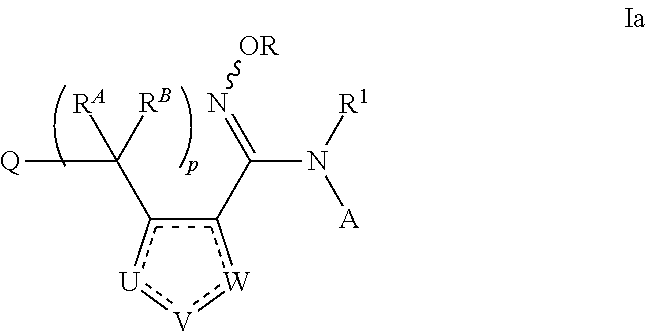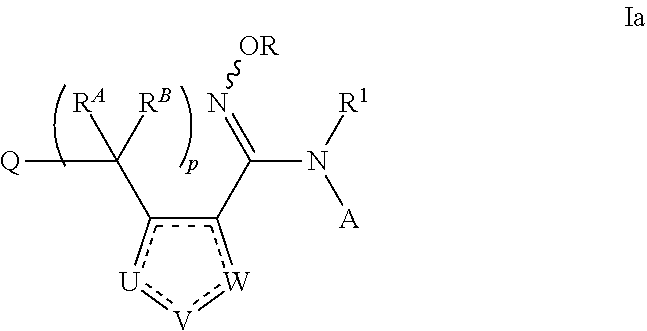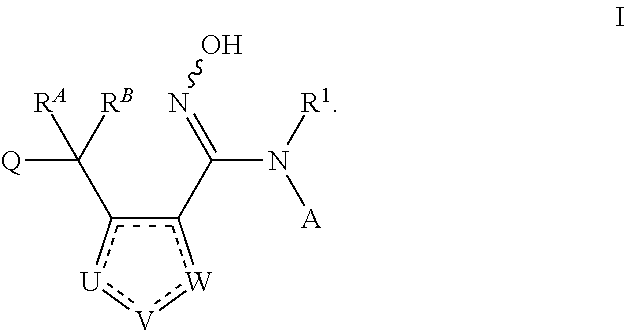N-hydroxyamidinoheterocycles as modulators of indoleamine 2,3-dioxygenase
a technology of indoleamine and hydroxyamidinoheterocycles, which is applied in the direction of antibody medical ingredients, drug compositions, immunological disorders, etc., can solve the problems of kynurenine metabolites such as quinolinic acid (quin), and unable to fully explain the survival of fetal allografts
- Summary
- Abstract
- Description
- Claims
- Application Information
AI Technical Summary
Benefits of technology
Problems solved by technology
Method used
Image
Examples
example 1
N-(3-Chloro-4-fluoro-phenyl)-N′-hydroxy-4-hydroxymethyl-furazan-3-carboxamidine
[0241]
Step A: 4H,6H-Furo[3,4-c][1,2,5]oxadiazol-4-one
[0242]
[0243]4H,6H-Furo[3,4-c][1,2,5]oxadiazol-4-one was synthesized according to literature procedures (Pollet, et al., Synthesis Communications, 1979, 977-979.) To a stirred solution of (3Z,4Z)-furan-2,3,4(5H)-trione 3,4-dioxime (3.0 g, 0.021 mol) in 1,4-dioxane (21 mL) under nitrogen, thionyl chloride (2.1 mL, 0.029 mol) was added dropwise. The resulting yellow solution was stirred overnight and then concentrated in vacuo. The resultant crystalline material was recrystallized once from a minimum amount of ethanol (EtOH) to give the desired compound as an off-white powder. The filtrate was concentrated down and recrystallized again. Combined solids yielded the desired product (2.0 g, 76%). 1H NMR (400 MHz, DMSO-d6) δ: 5.67 (s, 2H). MF=C4H2N2O3; LCMS calculated for C4H3N2O3(M+H)+: m / z=127.014.
Step B. N-(3-Chloro-4-fluorophenyl)-4-(hydroxymethyl)-1,2,5-o...
example 2
N-(3-Chloro-4-fluorophenyl)-N′-hydroxy-4-(phenoxymethyl)-1,2,5-oxadiazole-3-carboximidamide
[0259]
Step A: 4-(3-Chloro-4-fluorophenyl)-3-[4-(phenoxymethyl)-1,2,5-oxadiazol-3-yl]-1,2,4-oxadiazol-5 (4H)-one
[0260]
[0261]4-(3-Chloro-4-fluorophenyl)-3-[4-(hydroxymethyl)-1,2,5-oxadiazol-3-yl]-1,2,4-oxadiazol-5(4H)-one (15 mg, 0.0480 mmol), phenol (14 mg, 0.14 mmol) and triphenylphosphine (16 mg, 0.062 mmol) were dissolved in anhydrous THF (500 μL) then cooled to 0° C., followed by a dropwise addition of diethyl azodicarboxylate (9.8 μL, 0.062 mmol) in a solution of THF. Reaction was allowed to warm to rt then stirred 4 hrs. After concentration in vacuo, the sample was purified by reverse phase HPLC to yield a white powder (9 mg, 48%). MF=C17H10ClFN4O4; LCMS calculated for C17H11ClFN4O4(M+H)+: m / z=389.045
Step C: N-(3-Chloro-4-fluorophenyl)-N′-hydroxy-4-(phenoxymethyl)-1,2,5-oxadiazole-3-carboximidamide
[0262]Into a vial was added 4-(3-chloro-4-fluorophenyl)-3-[4-(phenoxymethyl)-1,2,5-oxadiazol...
example 3
4-[(E / Z)-[(3-Chloro-4-fluorophenyl)amino](hydroxyimino)methyl]-1,2,5-oxadiazol-3-ylmethyl phenylcarbamate
[0263]
[0264]4-(3-Chloro-4-fluorophenyl)-3-[4-(hydroxymethyl)-1,2,5-oxadiazol-3-yl]-1,2,4-oxadiazol-5(4H)-one (20 mg, 0.064 mmol), was dissolved in anhydrous DCM (400 μL). 4-Dimethylamino-pyridine (DMAP) (4 mg, 0.03 mmol) was added followed by addition of phenyl isocyanate (7.6 μL, 0.07 mmol). Reaction was stirred at rt for 24 hrs and then concentrated in vacuo. The crude was purified by HPLC to yield a white powder. The intermediate was redissolved in EtOH (0.7 mL) and 2 M of sodium hydroxide in water (60 μL) was added. Reaction was stirred for 2 hr at rt. Reaction was quenched with acetic acid and diluted with MeOH and then purified by preparative LCMS to yield the desired compound as a white powder (16 mg, 62%). 1H NMR (400 MHz, DMSO-d6) δ: 11.68 (s, 1H), 10.00 (s, 1H), 9.04 (s, 1H), 7.47 (d, J=8.1 Hz, 2H), 7.00 (m, 1H), 7.28 (dd, J=7.5, 8.0 Hz, 2H), 7.19 (dd, J=9.1, 9.1 Hz, 1H...
PUM
 Login to View More
Login to View More Abstract
Description
Claims
Application Information
 Login to View More
Login to View More - R&D
- Intellectual Property
- Life Sciences
- Materials
- Tech Scout
- Unparalleled Data Quality
- Higher Quality Content
- 60% Fewer Hallucinations
Browse by: Latest US Patents, China's latest patents, Technical Efficacy Thesaurus, Application Domain, Technology Topic, Popular Technical Reports.
© 2025 PatSnap. All rights reserved.Legal|Privacy policy|Modern Slavery Act Transparency Statement|Sitemap|About US| Contact US: help@patsnap.com



